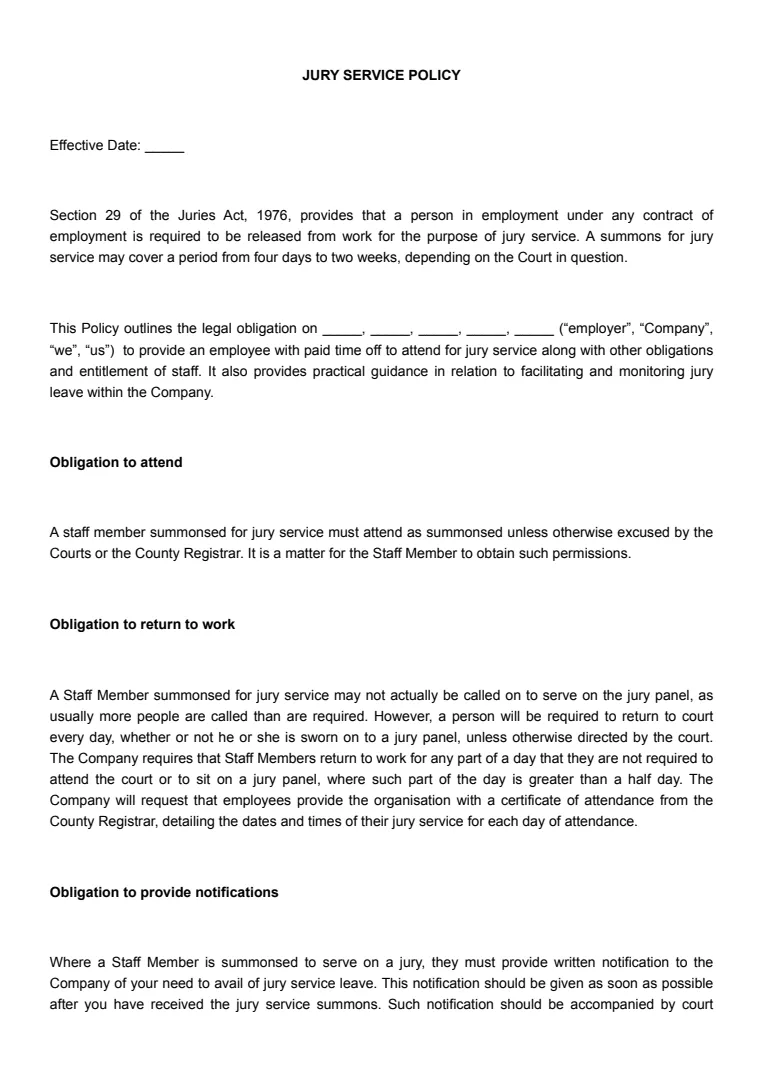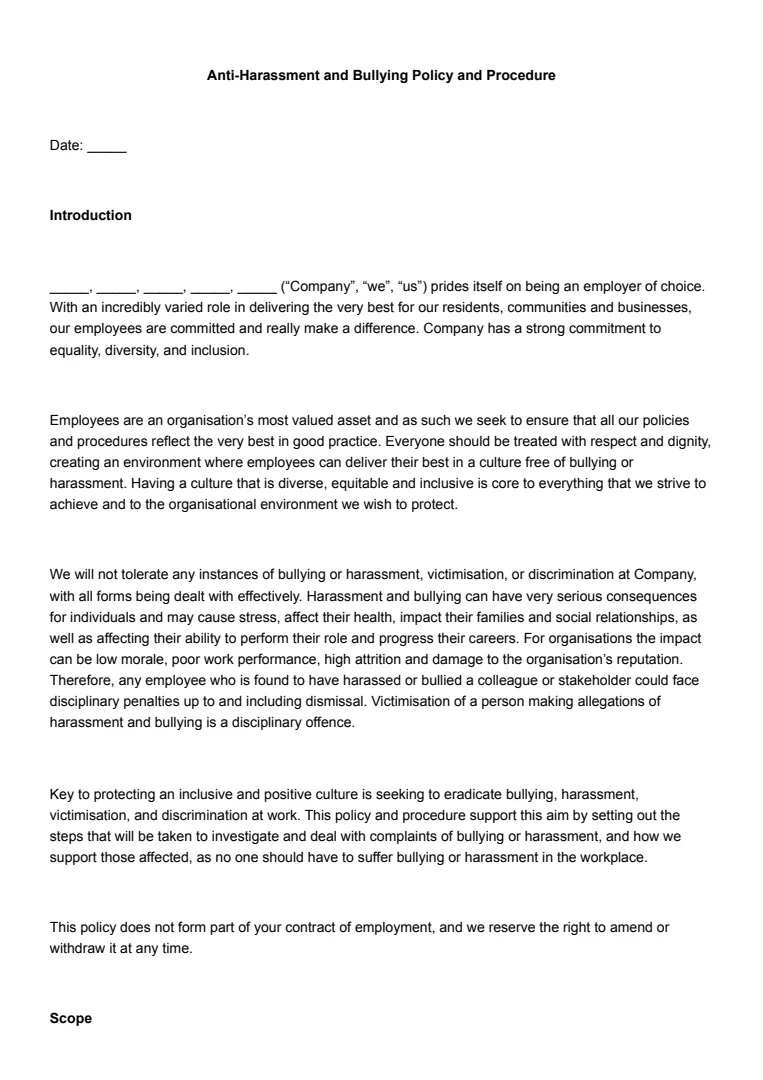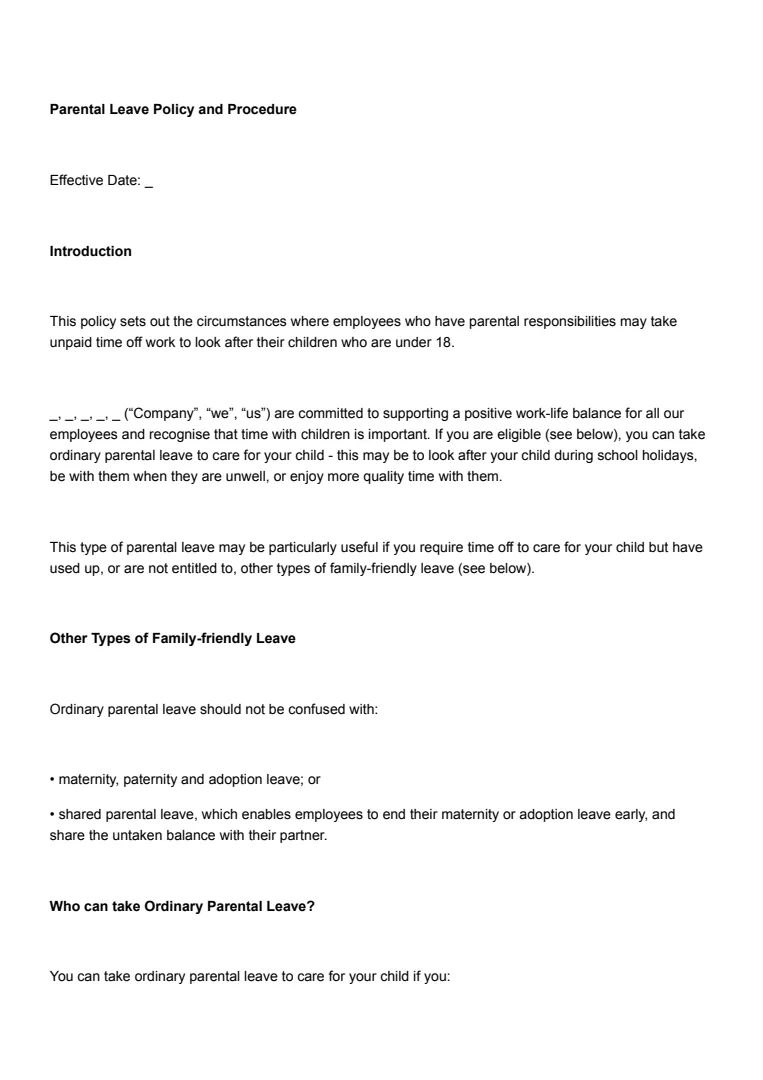What Is a Paternity Policy?
A paternity policy (also referred to as a paternity leave policy template) sets out the rules for taking paternity leave, including eligibility, duration, payment terms, and the process for making a request.
It draws from statutory entitlements under employment law, such as the Employment Rights Act 1996 and the Paternity and Adoption Leave Regulations 2002 in the UK, but may also include enhanced terms offered by the employer. For example, while the law provides a standard leave entitlement, employers may offer longer leave, higher pay, or more flexible arrangements as part of their workplace benefits.
The policy applies to fathers, partners, and in some cases, same-sex partners or intended parents via surrogacy, depending on the legal definitions in the jurisdiction. Having it documented ensures that both employer and employee have a shared understanding of what is available and how to access it.
When Should You Use a Paternity Leave Policy?
A paternity leave policy should be established and communicated to all staff before it is needed, and it is relevant in several scenarios.
1. When Hiring or Onboarding Staff
Introducing the paternity policy during recruitment or onboarding does more than simply inform new hires of their rights; it sets the tone for a supportive workplace culture. By proactively sharing the document, employers demonstrate a commitment to work-life balance and equality, which can improve retention and attract candidates who value family-friendly practices.
For example, a detailed policy can help reassure potential recruits that they will be supported when starting or growing their families, which can be a deciding factor for skilled professionals weighing multiple job offers. Including it in onboarding packs also ensures HR, managers, and employees are aligned from the outset on processes and expectations.
Expert Tip:
“Making your paternity policy visible during onboarding can increase new-hire satisfaction and engagement; employees who see strong family policies early are more likely to view the company as supportive and inclusive.”
2. When an Employee or Their Partner Is Expecting a Child
Once an employee confirms they are expecting to become a parent, having a clear paternity policy available can reduce stress during what is often a busy and emotional time. It becomes the go-to resource for understanding exactly how much leave is available, whether it can be split or must be taken in one block, and what documents are needed to apply.
For managers, it streamlines administrative processes, as they can point employees directly to the policy rather than answering the same questions repeatedly. It also helps teams plan workloads and handovers more effectively, ensuring business continuity while the employee is away.
3. When Offering Enhanced Benefits
Employers that provide benefits above the statutory minimum should use the policy to clearly communicate these extra entitlements, not just to meet compliance needs, but also to highlight them as a competitive advantage. For example, offering a month of fully paid paternity leave instead of the standard one or two weeks can position the business as a progressive employer that genuinely supports family wellbeing.
Documenting enhanced benefits ensures there is no ambiguity about eligibility, pay calculations, or application procedures, which in turn reduces potential disputes and boosts morale. It can also form part of wider employer branding efforts, helping to attract and retain talent in competitive sectors.
4. When Adapting to Legal Updates
Employment laws and statutory pay rates are subject to change, often annually. A written policy makes it far easier to implement these updates quickly and consistently across the organisation. Without a formal document, changes might be applied unevenly, leading to confusion or even non-compliance.
By maintaining a living policy that is reviewed at least once a year, or immediately after legislative changes, employers can avoid costly mistakes, such as underpaying eligible employees or miscalculating leave periods. An updated policy also helps managers stay confident when responding to employee queries, knowing they are working from the latest legal guidance.
How to Write a Paternity Policy
Clarity and compliance are essential when drafting a paternity policy, and it should be written in plain language so it’s accessible to all employees. Here’s a step-by-step guide to creating a robust paternity policy.
Step 1: Identify Applicable Laws and Eligibility Criteria
Begin by thoroughly reviewing the legislation that governs paternity leave in your jurisdiction. In the UK, for example, this includes the Employment Rights Act 1996, Paternity and Adoption Leave Regulations 2002, and Shared Parental Leave Regulations 2014. Your policy should clearly outline both the statutory minimums and any company-specific eligibility criteria.
This may include the length of service required before an employee qualifies, often 26 continuous weeks before the qualifying week, and the legal definition of the employee’s relationship to the child. Consider including specific guidance for non-traditional family structures, adoption cases, and surrogacy arrangements so the policy is inclusive and avoids ambiguity.
Step 2: Outline Leave Entitlements
Detail precisely how much leave is available, in what format it can be taken, and the time frame in which it must be used. For example, statutory paternity leave in the UK allows for one or two consecutive weeks, taken within 56 days of the child’s birth or adoption placement. If your organisation offers more generous terms, such as the option to split leave into separate weeks or extend it beyond the statutory limit, highlight these differences clearly.
Where possible, include examples showing how entitlements work in different scenarios, such as multiple births or delayed adoption placements. This helps employees understand their rights without needing further clarification.
Expert Tip:
“Be explicit about leave structure. Employees are less likely to take advantage of their entitlement if the rules around splitting or deferring leave are unclear.”
Step 3: Detail Pay Provisions
Clearly explain what level of pay applies during paternity leave and the conditions for receiving it. Statutory Paternity Pay (SPP) is currently set at a fixed weekly rate or 90% of the employee’s average weekly earnings (whichever is lower), but employers may choose to offer enhanced pay.
The policy should state whether this is available, how it is calculated, and if it applies equally to all eligible employees. Consider addressing how payments are processed, for example, whether they are paid through normal payroll or as a lump sum, and whether they are subject to tax and National Insurance contributions. Including this level of detail helps prevent payroll disputes and ensures employees can plan their finances.
Step 4: Explain the Application Process
A clear, step-by-step application process reduces delays and errors when employees request paternity leave. Specify the minimum notice period; in the UK, this is usually at least 15 weeks before the expected week of childbirth, and detail any internal forms or online HR systems that must be used.
Include a list of required supporting documents, such as a MATB1 form (for birth) or an adoption matching certificate. If your organisation has different processes for statutory and enhanced benefits, clarify the differences to avoid confusion. It’s also good practice to note whether confirmation will be given in writing, which adds a layer of administrative security.
Expert Tip:
“Always request documentation early. Missing forms or certificates are the most common cause of delays in processing paternity leave.”
Step 5: Address Return-to-Work Rights
Reassure employees that their right to return to the same job, with the same terms and conditions, is protected by law. Where applicable, mention any internal processes for reintegration, such as return-to-work meetings, workload updates, or training refreshers.
If your organisation supports flexible working requests after paternity leave, for example, reduced hours, hybrid arrangements, or compressed workweeks, outline the process for making such requests, referencing any relevant legislation like the Flexible Working Regulations in the UK. Including guidance on how career development, bonuses, or performance reviews will be handled post-leave can further reinforce the organisation’s commitment to supporting working parents.
Legally.io’s free paternity policy template already includes all these clauses, saving you hours of drafting and reducing the risk of missing critical protections.
What Should a Paternity Policy Contain?
A well-structured paternity policy should include:
- Purpose and scope – The reason for the policy and who it applies to.
- Eligibility – Service length requirements, relationship to the child, and employment status criteria.
- Leave duration – The exact entitlement and when it can be taken.
- Pay – Clear details on statutory or enhanced pay and payment methods.
- Application process – Steps for requesting leave, including deadlines and required documents.
- Employee obligations – Any expectations for communication, documentation, or work handovers.
- Return-to-work rights – Assurance of role security and terms continuity.
- Relevant legislation – References to applicable laws and regulations for compliance.
Including these elements ensures transparency, supports legal compliance, and makes the process smoother for all parties involved.
Legal Tips for Paternity Policies
Bear in mind the following expert legal tips when creating and implementing paternity policies.
- Stay updated on legislation – Review the policy annually to incorporate any changes in statutory leave or pay.
- Address equality and non-discrimination – Ensure the policy applies equally to all eligible employees, regardless of gender identity or family structure.
- Protect sensitive information – Comply with data protection laws when handling employee information related to paternity leave.
- Clarify interaction with other leave types – For example, explain how paternity leave interacts with shared parental leave, annual leave, or compassionate leave.
- Include guidance for managers – Ensure line managers know how to respond to leave requests, approve them, and manage workloads during absences.
Key Takeaways
A paternity policy is an essential tool for ensuring that both employer and employee understand their rights, responsibilities, and entitlements surrounding paternity leave.
It should be clear, legally compliant, and regularly reviewed to reflect legislative changes.
A comprehensive policy supports staff morale, demonstrates an inclusive workplace culture, and minimises the risk of disputes.
Using Legally.io’s professionally drafted, jurisdiction-specific template can help you create a policy that is both thorough and easy to implement.













